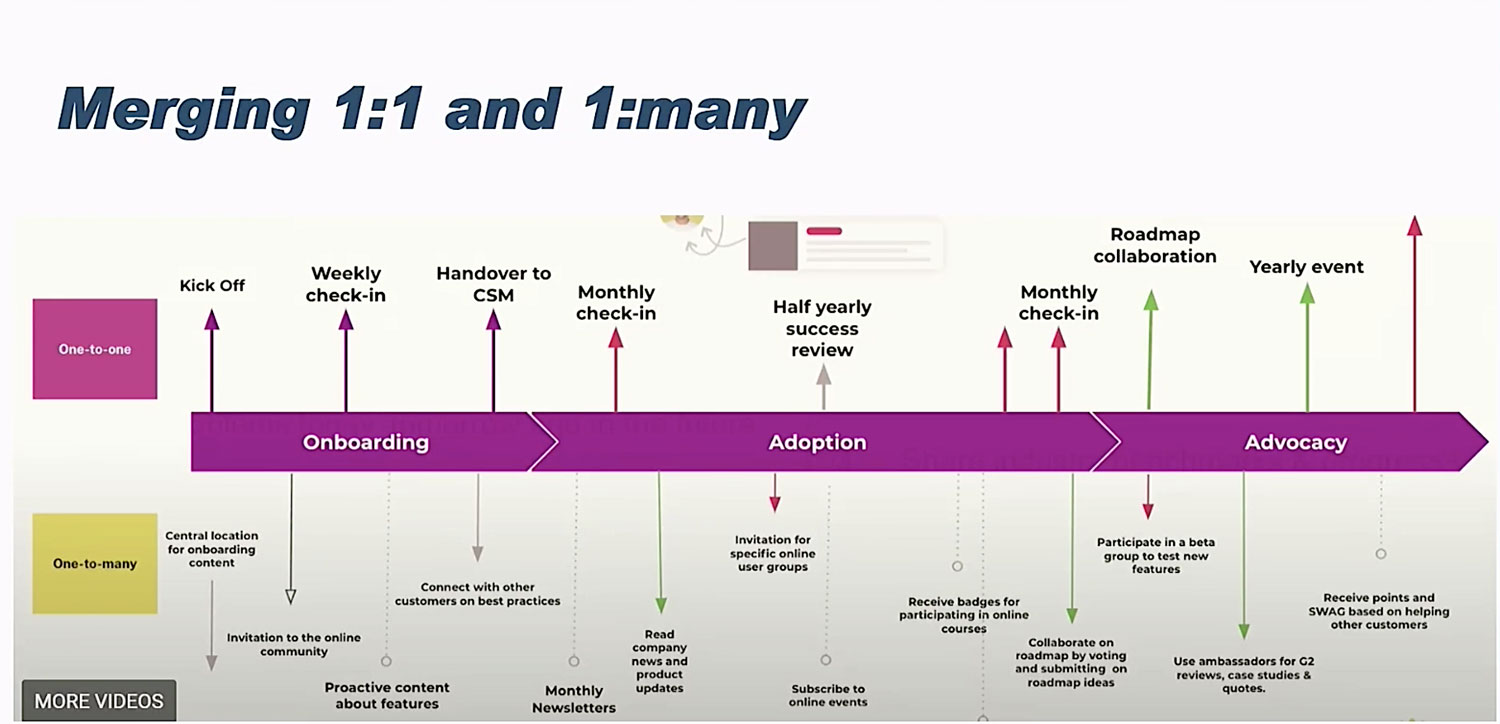Originally published on inSided.com on September 30, 2022.
When it comes to Community, there’s a common misconception that it’s best for companies who have 500 or more customers per CSM. And it can offset support cases and help with ticket deflection.
But the truth is:
Community or a digital strategy is of value to ANY customer and ANY CSM, regardless of your touch style or size of the customer.
In fact, Cognite’s model shows that Community can solve a variety of problems like a fractured customer experience, low content adoption, and product-customer gaps.
Here are our takeaways from Cognite’s Pulse 2022 session on how to leverage Community to solve key CS challenges.
Why high-touch CS teams need community, too
Mixed-touch and tech-touch CS teams may struggle with problems like support ticket overwhelm, but high-touch CS teams face slightly different problems.
Unlike some startups that struggle with content creation, Cognite was struggling with the opposite. With an abundance of content from 12 different locations, users couldn’t find what they were looking for. They needed a vehicle to unify all of it and deliver it in an accessible way.
These were some of their top challenges:
- Fractured customer experience: Customers need to visit different places to access content, with low navigability of available resources and a jarring gap between the pre- and post-sale customer experience.
- Low content adoption: A fractured technology stack that limits the ability for 1-to-many many messaging of content to customers, resulting in little awareness and discoverability of relevant content.
- Product customer gaps: No intuitive channel or way for product to engage with customers so the loudest voice wins, resulting in low customer empathy.
When Cognite faced these challenges, they decided that building a Customer Community would solve these problems by creating a unified customer digital experience.
Here’s how they did it.
The solution: Merging 1:1 and 1-to-many through Community
How do you unify your customer journey and tech stack to create a frictionless digital experience for your customers? You create a centralized digital destination—a community.
Or, simply put: create one place for your customers to go. Ideally, that destination exists both in- and outside of your product for a more frictionless experience. This is exactly what Cognite built when they launched their Cognite Hub in 2021.
1. From fractured to unified customer journey
In every customer journey, there are many different touch points—both 1:1 and 1-to-many. For example, customers will get a QBR, a sales-to-CS handoff, an invitation to the next product beta group, and more.
But we don’t always think enough about how our customers experience all of those touch points that happen across 12 different sites or places. Often, there’s no one unified tech stack or digital experience.
That was the case for Cognite.

According to Alex Farmer, VP of Customer Success at Cognite, the first step on your community roadmap should be to unify all of the one-to-many events and content in one place. That includes your product release documentation, your LMS system, your support case portal, and your status page—all in one place.
As a result, customers always know where to go: the community. From there, it’s key to continuously direct them to the community as their go-to customer hub.
Next, and directly connected, is creating a frictionless overall digital customer experience.
2. Fill in experience gaps with a seamless tech stack
A unified customer journey and customer experience all depend on a seamlessly integrated tech stack.
We all know this to be true.
But, raise your hand if your tech stack looks something like this:
- The Support team has its own system.
- The Onboarding team has its LMS.
- The Product and Engineering teams each have their own tools.
At Cognite, this was also the case. Each departmental section had its own customer-facing section. The Product team, for example, had a location where customers can log enhancement requests.
But as Farmer notes, that’s essentially outsourcing your org chart to your customer’s experience with a tech stack siloed by department. At the end of the day, the customer doesn’t care which department they’re engaging with. They care that they can get their desired outcome solved and have a frictionless digital experience.
“The customer doesn’t care which department they’re engaging with. They care that they can get their desired outcome solved with a frictionless digital experience.”
-Alex Farmer, VP of CS, Cognite
That’s where Community comes in. Cognite realized their customers needed a single source of truth via a unified customer hub.
3. Increase content adoption with a unified customer hub
Using the example of having 12 existing disparate systems, one common mistake businesses make when launching their first community is to treat the community as the 13th system. Cognite wanted to ensure this wasn’t the case.
As Farmer notes, a customer doesn’t just decide one day out of the blue, “You know what? I’m going to go to the community for that.” Without any guidance, it’s not intuitively the first place they will go. Instead, they’ll likely go to support for an issue.
The solution?
Make community your “cover sheet” or the central entry point for your customers to find the content, knowledge, events, answers, or whatever they are seeking.
For the Cognite hub, that included:
- New customer welcome pack: what to expect, CS team plan in first 30 days, access to onboarding documents
- Early adopter feedback groups: For major releases, CS teams nominate customers to join and directly develop with them in a private group.
- Product ideation integrated into Productboard: The product team engages with Productboard to understand enhancement requests, whether from employees or customers.
- Use case library and customer case studies: help customers understand what’s possible and what they can do to drive adoption and upsell
- Integration to support and documentation via federated search
Ultimately, it’s all about building a solid community foundation and training that “muscle memory” within your customer base that community is where you go to find what you need.
From there, it’s all about continuing to develop opportunities for Community-Led Growth—more important than ever in tough economic times.
The future of Community is now: Community-Led Growth
Community-led growth puts the users in the driver’s seat and lets you cruise in the passenger seat.
Here’s how it works.
Merging 1:1 and 1-to-many
One example from Cognite is merging a private group on the customer hub for each customer storing a repository of all the QBR decks, Customer Success plans, and onboarding documents.
So instead of building out a beautiful QBR deck, having a successful two-hour conversation with your executive sponsor then emailing them a PDF attachment of the QBR deck slides with bullet points and never revisiting it again, you can share it on your Community so plenty of others can utilize these resources and benefit from your work.
Empower your customers to simultaneously engage with 1-to-many content and with 1-to-1 content. That’s the vision of merging the two.
Micro-targeting
Community opens up a whole new opportunity for account-based marketing, or micro-targeting, allowing you to targeting a specific account with a different message for individual accounts. So why not do this with customers too?
One of the strategies Cognite Hub is currently experimenting with is micro-targeting what the hub experience looks like for each customer, effectively combining customer health scoring and community. Perhaps a red account should see a different homepage or have different resources available.
For a customer going through an upsell to buy a new module, you might include a link to a case study about that module. All of this is possible because the Community platform allows you to pipe in customer health scores and other data points directly into your community so you can drive more net dollar retention, more upsell, and save accounts through their community experience.
Community is the new marketing
For most businesses, the vast majority of revenue comes from existing customers. Yet marketing investment, messaging, and resources are targeted toward acquiring new customers at a much higher rate.
So how to capture the post-sale demand of your customers?
Farmer says Cognite has an idea and they’ve already put it into practice: the Community Qualified Lead or the post-sale counterpart to a Marketing Qualified Lead. Many in the industry have been talking about the Customer Success Qualified Lead (CSQL). But further up the funnel than a CSQL, is a Community Qualified Lead (CQL).
Cognite’s strategy for capturing CQLs starts with its use case library. Let’s say a customer is in the Community, reading about a possible use case, and discuss it with their CSM. That’s a CQL. Or perhaps they’ve clicked to enroll in a training course. That’s another CQL.
That’s how you get the Community-led Growth flywheel in motion for a high-touch customer success and beyond.
READ: Why Community needs a seat at the table (and how to get one)
Final thoughts
Hopefully, by now you have seen the many use cases for Community that stretch far beyond taking the burden off your Support teams.
But in conclusion, Community for high-touch CS Teams looks like unifying your customer experience, increasing content adoption, filling in product customer gaps, and amplifying your marketing efforts.
Whether your CS team is high-touch, tech-touch, or both, Community is a high ROI, growth-building investment.
Learn More
Looking create a single destination for your customers to connect, share best practices, provide feedback, and build a stronger relationship with your product?
Schedule a demo to discover the community platform that keeps your customers coming back for more.

